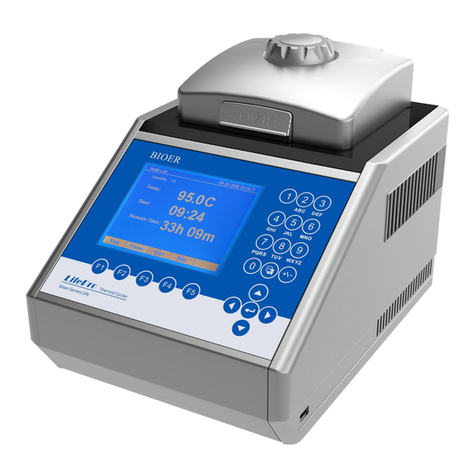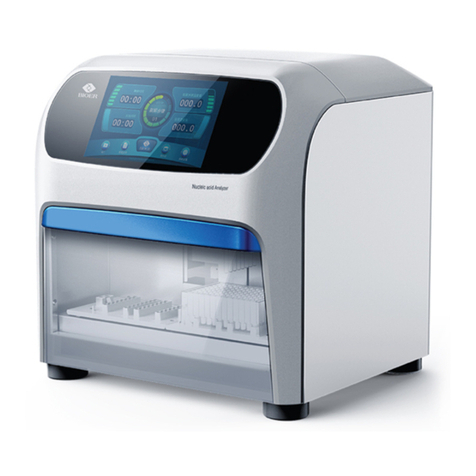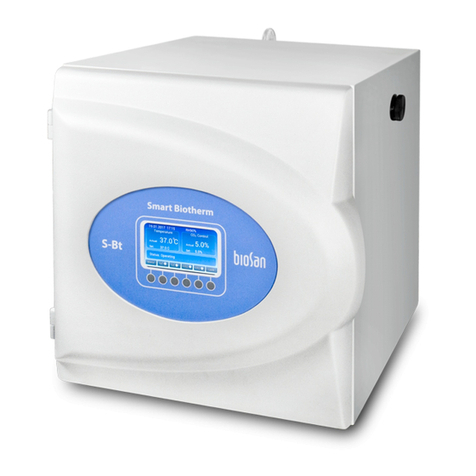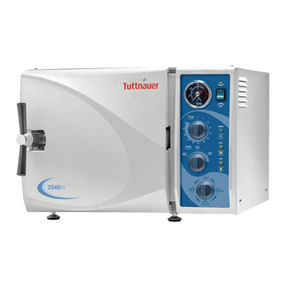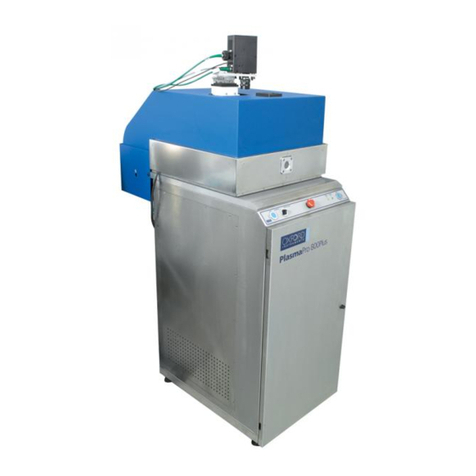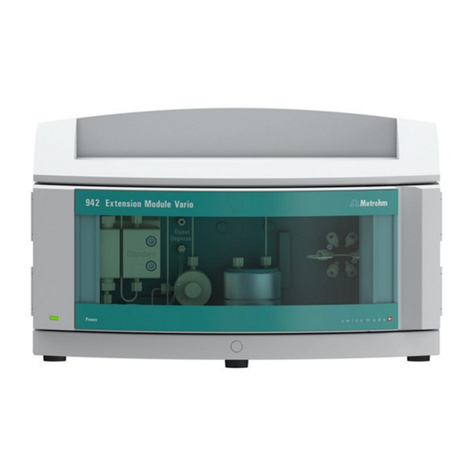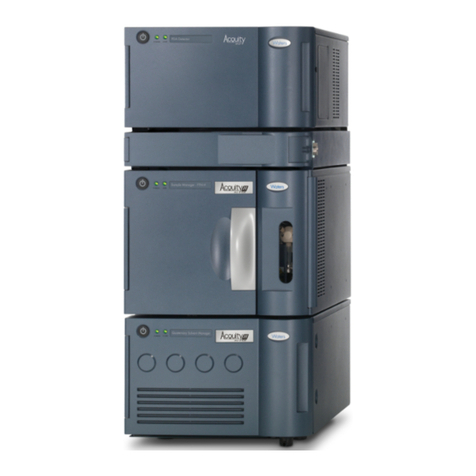Bioer GeneExplorer Series User manual

Thermal Cycler
(GeneExplorer Series)
Operation Manual
Hangzhou Bioer Technology Co., Ltd.

Note:
Please understand that no further notice will be given for any
modification to the information contained herein.
The document contains patent information under copyright protection. All rights
reserved. Without prior written approval from Hangzhou Bioer Technology Co., Ltd., any
part of the document shall not be copied, re-produced or translated into other language.
Product patent No.: ZL 98 2 44367.6
Product technology requirement No.:
Product registration No.:
Medical device production license No.:
Document No.: BYQ56270000000ESM
Document version: Dec. 2019 Edition 1.0
Before using the instrument for the first time, please
carefully read t h e Op er a ti on Manual
!

GeneExplorer Thermal Cyeler Operation Manual Important Notes
—i —
Important Notes
1Convention
Attention:
Information of extreme importance is contained under the item of Attention, thus
please carefully read it. Failure to practice as per the instruction may lead to
equipment damage or operation failure.
Warning!
Information under the item of Warning requires special attention for specific
operation step or method. Failure to practice as per the requirements may lead to
severe personal injury.
2Safety
The following basic safety measures must be abided by through all stages including equipment
operation, maintenance and repair. Failure to abide by these measures or warnings indicated in the manual
may affect the protection provided by the instrument. Meanwhile, it may damage the safety standard for
design and manufacturing , and expected application scope of the instrument.
Hangzhou Bioer Technology Co., Ltd. takes no responsibility for any consequences arising from user’s
failure for abiding by the following requirements.
Attention:
The instrument is Type-I equipment in line with GB4793.1 standard with protection
level of IP20. The instrument is designed for indoor use.
Attention:
The instrument is in-vitro diagnostic (IVD) medical equipment in line with
YY0648 standard.
A) Instrument grounding
To prevent electric shock, the input power line of the instrument must be reliably grounded. The
instrument adopts three-core grounding plug which includes a third (grounding) foot and can only used
together with grounding socket. This is a safety device. If the plug cannot be inserted into socket, please
ask an electrician to install correct socket, and don’t let the grounding socket lose its function of safety.
B) Keep away from energized circuit
Operator should not arbitrarily dismantle the instrument. Component replacement or in-machine
adjustment must be completed by specialized maintenance personnel with certificate. Don’t replace any
component when the power line is connected.
C) Attention for power supply
Before connecting AC power supply, ensure the consistence of the voltage of the power supply and the

GeneExplorer Thermal Cyeler Operation Manual Important Notes
—ii —
voltage required by the instrument (a deviation of 10% is allowed), and ensure the rated loading of the
power socket is no less than the requirement of the instrument.
D) Attention for power line
Generally, the instrument should use the power line supplied along with the instrument. In case of
power line damage, it must be replaced instead of repair. For replacement, power line of same type and
specification should be used. Don’t put anything on the power line when the instrument is being used.
Don’t place the power line in the place where people walk through. If the power line will contact thermal
surface when it is used, then protection measures should be taken to prevent insulation damage to the
power line.
E) Plug in and plug off
The plug must be held in hand for plugging in and plugging off. For plugging in, ensure that the plug
is completely inserted into the socket, and don’t pull the power line forcibly for plugging off.
F) Attention for instrument placing
The instrument should be placed in area of low humidity, less dust and far away from water source
(such as close to water pool or water pipe), and the place should be well ventilated and free from corrosive
gas or high magnetic field interruption. Don’t place the instrument in moisty or dusty area. Also, don’t
place the instrument in area making it difficult to operate the disconnecting device.
Openings on the instrument are designed for ventilation. To avoid over heating, don’t bloeck or cover
the ventilating openings. For single machine operation, the ventilating openings on the instrument should
be kept at least 20cm away from nearest objects. For simultaneous multiple machine operation, the distance
between instruments should be no less than 10cm. Additionally, don’t use the instrument on floppy surface;
otherwise the ventilating openings at instrument bottom may be blocked.
Over-temperature will affect the instrument performance or lead to faulty. Don’t use the instrument
under direct sunlight and keep the instrument away from heater, furnace and other heat source.
When the instrument is not in use for an extended period, unplug the power supply and cover the
instrument with soft cloth or plastic paper to prevent dust entering in the machine.
Warning:
The equipment should not be installed on the surface of inflammable
materials!
G) Attention for operation
During experiment operation, avoid liquid dripping on the instrument.
When dealing with reagent, wear personal protective equipment such as protective gloves.

GeneExplorer Thermal Cyeler Operation Manual Important Notes
—iii —
3Instrument label
Warning sign
Warning!
The instrument is pasted with a label of “HOT SURFACE!”. Any part of body is
strictly prohibited from touching the metal part (module and hot lid) around the label
during instrument operation or within a certain period after the program ends.
Warning!
The instrument is pasted with label of BIO-RISK, which indicates that the instrument
presents potential infectivity due to sample or reagent.
4Instrument maintenance
Periodically use clean soft cloth dipped with ethanol to clean the block wells on module to ensure
sufficient contact between test tubes and taper holes and to ensure favorable heat conduction. If there is any
dirt on the instrument surface, use soft cloth dipped with cleansing cream to clean.
Warning!
The power must be cut off when cleaning the instrument surface.
Corrosive detergent is strictly prohibited from being used to clean the instrument
surface.
Attention:
In any of the following cases, immediately unplug the power supply from the
socket, and contact the supplier or ask qualified maintenance personnel for
treatment:
Liquid enter into the instrument;
The instrument is exposed to rain or wet by water;
The instrument fails to work normally, especially there is any abnormal sound
or flavor;
The instrument drops down or the shell is damaged;
The instrument function has evident change;
For any doubt concerning the compatibility between detergent and equipment
part or materials contained in the equipment, please consult the manufacturer
or its agent.

GeneExplorer Thermal Cyeler Operation Manual Important Notes
—iv —
5After-sales service
See the Warranty Card for specific content and scope of warranty.
Attention:
After opening the packaging box, immediately check the objects contained therein
based on the packing list. In case of any object damage or missing, please
immediately contact the supplier.
After acceptance inspection, fill out the Acceptance Inspection Form and send the
copy (or fax) back to the company for filing and warranty service.
After the packaging box is opened, please properly keep the packaging box and
packing materials which will be used during maintenance. Hangzhou Bioer
Technology Co., Ltd. will take no responsibility for instrument damage caused by
improper packaging during transport to the maintenance department.

GeneExplorer Thermal Cyeler Operation Manual Important Notes
―1-
Contents
Chapter One Introduction................................................................................................................................2
1Introduction to PCR technology......................................................................................................2
2Examples of PCR’s applications .....................................................................................................2
3Features of GeneExplorer thermal cyeler........................................................................................2
4Use of GeneExplorer thermal cyeler...............................................................................................3
5Service life of thermal cyeler ..........................................................................................................3
Chapter Two Characteristics ...........................................................................................................................4
1 Normal operation conditions................................................................................................................4
2 Transport and storage condition...........................................................................................................4
3 Basic parameters ..................................................................................................................................4
4 Software functions................................................................................................................................5
5 Software version...................................................................................................................................5
Chapter Three Preparations.............................................................................................................................6
1 Structural schematic diagram...............................................................................................................6
2 Check before turning on the instrument...............................................................................................7
3 Turn on the instrument .........................................................................................................................7
Chapter Four Operation Instructions...............................................................................................................8
1 Turn on the instrument .........................................................................................................................8
2 PCR program editing..........................................................................................................................10
2.1 Setting of program section ......................................................................................................10
2.2 Section temperature and constant temperature time................................................................11
2.3 Function of loop ......................................................................................................................11
2.4 Extended parameter.................................................................................................................13
2.5 Save experiment......................................................................................................................13
3 Run program.......................................................................................................................................13
3.1 Temperature control mode.......................................................................................................15
4File management ...........................................................................................................................16
5 System settings...................................................................................................................................18
5.1 Personal Center .......................................................................................................................18
5.2 System Settings .......................................................................................................................18
6 Software upgrade................................................................................................................................19
6.1 UI program upgrade ................................................................................................................19
6.2 Driver upgrade.........................................................................................................................20
Chapter Five FaultAnalysis and Troubleshooting ........................................................................................21
1 Fault analysis and troubleshooting.....................................................................................................21
Appendix 1 Wiring Diagram (the diagram is only for reference, and please understand that no
further notice will be given for any modification) ................................................................................23
Appendix 2 Value and Meaning of Set Parameters..........................................................................24
Appendix 3 Product EMC Statement ....................................................................................................26
Appendix 4 List of Accessories.............................................................................................................28
Contents

GeneExplorer Thermal Cyeler Operation Manual Important Notes
―2-
Chapter One Introduction
The chapter covers introduction to PCR technology and examples of its applications, introduction to
PCR thermal cyeler and features of GeneExplorer thermal cyeler.
1Introduction to PCR technology
Polymerase Chain Reaction (PCR in short) is a nucleic acid amplification technology of in-vitro
simulation of natural DNA reproduction process. With two DNA chains to be amplified as a template and
mediated by a pair of artificially synthetic ODN primers, and through DNA polymerase of high
temperature resistance, it can rapidly and specifically amplify specific DNA segment. Due to its simplicity,
rapidity, peculiarity and sensitivity, ever since invention of PCR by Mullis in 1985 and discovery of DNA
polymerase of high temperature resistance by Erlich in 1988, over a few years, the technology has been
widely applied in various fields of bioscience. Especially in cytology, virology, oncology, genetic
epidemiology, forensic pathology and flora and fauna immunology, it has accomplished outstanding
achievements and become a milestone of contemporary molecular biology development.
2Examples of PCR’s applications
Application of thermal cyeler: The product is applicable to polymerase chain reaction in fields
including immunology, human genome engineering, forensic pathology, oncology, organization and
population biology, paleontology, zoology and botany.
3Features of GeneExplorer thermal cyeler
GeneExplorer thermal cyeler is a PCR of multiple functions and applications. It features as below:
Providing up to eight replaceable modules based on requirements of various PCR experiments;
Adopting advanced American ITI thermoelectric refrigeration technology and thermoelectric
refrigeration element manufactured under Japanese quality management mode which presents stable
and reliable performance;
Maximum ramp rate up to 4C/s, and can be adjusted based on experiment requirements;
Multiple temperature control modes and higher reagent compatibility;
Host machine of GeneExplorer thermal cyeler can automatically recognize module and run
corresponding program;
Colorful large-screen display, humanized operation interface, simple and clear operation;
Power-off protection function, and after power supply recovery, it can continue to complete the
program unfinished;
Hot lid can adjust height and pressure based on actual using condition to adapt to different reaction
Chapter One Introduction

GeneExplorer Thermal Cyeler Operation Manual Important Notes
―3-
tubes and effectively prevent reagent evaporation and pollution;
USB standard port can be connected to general computers, convenient for software upgrade.
4Use of GeneExplorer thermal cyeler
GeneExplorer thermal cyeler, taking a leading position among similar products, has combined various
advanced technologies and can meet requirements of various PCR experiments.
Suitable consumables of GeneExplorer thermal cyeler are as follows.
5Service life of thermal cyeler
Service life of thermal cyeler is 5 years from the date of instrument installation.
GE-48DS:48×0.2ml+48×0.2ml
(1) 0.2ml standard centrifuge tube
(2) 8 connected tube
(3) none-skirt and semi-skirt
Standard 0.2ml PCR tube
Chapter One Introduction

Gene Explorer Thermal Cyeler Operation Manual Chapter Two Characteristics
―4-
Chapter Two Characteristics
The chapter mainly introduces the operation, transport and storage conditions of the instrument,
and its basic parameters, performance and functions.
1 Normal operation conditions
Ambient temperature: 10C ~ 30C
RH: ≤70%
Power supply: 220V~50Hz
Altitude: <2km
Attention:
Before using the instrument, please confirm if the working conditions can meet the
above requirements. Pay special attention to reliable grounding of the power line.
2 Transport and storage condition
Ambient temperature: -20C ~ +55C
RH: ≤80%
3 Basic parameters
Product name
GeneExplorer
Product No.
BYQ6627E
Model
GE-48DS
Features
Double block ,each block contains 3×16-well-module,with 3
seprate Peitier to control the temperature indepentently
Sample size
6×8 connected tube ,48×0.2ml+48×0.2ml
Heating rate(Avg)
≥3.5℃
Cooling rate(Avg)
≥3℃
Temperature unifornity
≤±0.25℃
Temperature accuracy
≤±0.25℃
LCD display
Color touch screen (8 inch, 260,000 colors)
Temperature range
4.0-105°C (min. resolution: 0.1°C)
File saving amount
≥2000 standard programs
Energy consumption
1200W
Dimensions
420mm×269mm×254mm(L×W×H)
Net weight
13kg

Gene Explorer Thermal Cyeler Operation Manual Chapter Two Characteristics
―5-
Attention:
When the set value of hot lid temperature is lower than the set value of module
temperature, the hot lid temperature displayed on the screen will be higher than the
set value of hot lid temperature.
4 Software functions
(1) file edit (including file number, temperature and time of each section, setting of loop times, view,
revise and delete file, automatic file connection, gradient temperature setting; maximum number of
editable sections is 10, maximum number of steps is 100, maximum number of loop is 99, available
for secondary nesting, gradient temperature range is -6℃~6℃);
(2) file storage;
(3) file modification (including adjustment of ramp rate, automatic temperature & time
modification during cycling, time display and calibration);
(4) setting of temperature, time and loop times during file running, and display of instant values
(including voice prompt, estimation of overall and remaining time of file running, fault protection and
warning);
(5) stop file running (including pause file running, stop file running and automatic recovery after
outage).
Attention:
The above software functions are only for reference. Please understand that no
further notice will be given for any modification to the software functions.
5 Software version
Software version : V1.0

Gene Explorer Thermal Cyeler Operation Manual Chapter Three Preparations
-6-
3
2
Chapter Three Preparations
The chapter mainly introduces the instrument structure, operation of touch screen, and preparations
before turning on the instrument. If the instrument is used for the first time, please be familiar with the
contents in the chapter before turning on the machine.
1 Structural schematic diagram
The structural parts of the instrument include heating module, hot lid, power switch module (including
power switch, power socket, and fuse holder), and micro-computer controller and touch screen.
6
7
1
4/5

Gene Explorer Thermal Cyeler Operation Manual Chapter Three Preparations
-7-
2 Check before turning on the instrument
Before plug in and energize the instrument, please confirm the following:
1Confirm the power supply meets the voltage required by the instrument; (see Chapter Two for
power supply requirements)
2Confirm that the power supply plug has been reliably inserted into the power socket;
3The power line is reliably grounded.
3 Turn on the instrument
Turn on the power switch (switch to the position of “–”), and then the instrument will carry out self-test
which will take about 20s, please wait patiently. If the self-test has discovered no problems, the main
interface will show on the screen, and you can edit, view, revise or delete PCR amplification files.
modules
hot lid
LCD screen
power socket
power switch
USB port
network port
Attention:
1、Requirements for fuse: 250V 12A 520. For fuse replacement, product which is
in line with the requirements should be used. Contact the supplier or manufacturer if
you need fuse.

Gene Explorer Thermal Cyeler Operation Manual Chapter Four Operation Instructions
-8-
Chapter Four Operation Instructions
In this chapter, the methods of editing, viewing, revising and deleting PCR
amplification files are introduced in detail, as well as the method of running PCR
amplification files and setting of instrument system parameters.
Warning!
After the instrument is turned on, if there is any abnormal sound or display, or
fault alarm and prompt presents during instrument self-test, please
immediately turn off the power and contact the supplier.
Attention:
If the sample volume of your experiment is less than the number of cone
holes of the module, please evenly distribute the test tubes to ensure stable
press of the hot lid on the test tube tops, which will also contribute to uniform
module loading and ensure uniformity of temperature change in each test
tube.
1 Turn on the instrument
Turn on the power switch and then the instrument will carry out self-test, please wait patiently. If the
self-test has discovered no problems, the main interface will show on the screen.
Module Type is displayed at bottom left of the main interface. At the middle of the main
interface, it displays four functions of software which are New Experiment, Open
Experiment, Recently Opened and Settings.

Gene Explorer Thermal Cyeler Operation Manual Chapter Four Operation Instructions
-9-
Press the icon “New Experiment” to enter into the interface of experiment parameter
setting.
Press the icon “Open Experiment” to enter into the interface of file list.

Gene Explorer Thermal Cyeler Operation Manual Chapter Four Operation Instructions
-10 -
Press the icon “Recently Opened” to view experiment.
Press the icon “Settings”to enter into Personal Center and System Settings.
During operation, instrument operation status is displayed on the main interface, and click
to enter into the interface of operation monitoring.
When operation is stopped, click to enter into the interface of experiment parameter
setting.
2 PCR program editing
Click “New File” on the main interface, or click “New Experiment”under “Open
Experiment”or “Recently Opened”to enter into the interface of program setting.
2.1 Setting of program section
Select one section of the program and the section will light up; click “Section”, then
there will prompt the checkbox of “Insert” and “Add”. Click “Insert”, a new section will be
added before the section selected and lighting up. Click “Add”, a section will be added to the
end of the program.
Click “Delete” to delete the section selected.

Gene Explorer Thermal Cyeler Operation Manual Chapter Four Operation Instructions
-11 -
2.2 Section temperature and constant temperature time
On the interface of PCR program setting, click the small icon on upper right of the screen,
and it will prompt the temperature and time setting box for setting temperature and constant
temperature time of the program section.
Run mode: Standard Mode and High-speed Mode.
Standard Mode running characteristics simulate BIOER TOUCH series.
2.3 Function of loop
On the interface of PCR program setting, click “Loop”, and it will prompt interface 1-1,
select the starting and ending sections of the loop, click “Determine” and it will prompt the
setting box 1-2 for loop times, input the times and click “OK”, the setting of loop section will
be finished.
Attention:
In one program, multiple loop sections can be set, but these sections cannot
be crossed, but only paralleled or included.

Gene Explorer Thermal Cyeler Operation Manual Chapter Four Operation Instructions
-12 -
Interface 1-1
1-2

Gene Explorer Thermal Cyeler Operation Manual Chapter Four Operation Instructions
-13 -
2.4 Extended parameter
On the interface of PCR program setting, click “Extended parameter”and it will
prompt a box for setting extended temperature, extended time, speed, and gradient and other
operations.
Extended temperature: the volume of temperature increase or decrease for each loop.
“-/+” changes the positive and negative of data.
Extended time: time increase for each loop.
Speed: ramp rate
Ladder Temp: It refers to the temperature difference between two adjacent modules .The
range is -6℃~6℃. “Temperature” is set to the temperature of the leftmost module.
2.5 Save experiment
On the interface of PCR program setting, click “Save”, and input user name and file
name to save the file. Files saved can be found under “Open Experiment”.
3 Run program
Before running experiment, set up hot lid temperature, reaction volume, temperature
control mode and control mode on the interface of PCR program setting and then click “Run”
to start the experiment. You can also run experiment by directly selecting the file under
“Open Experiment”and “Recently Opened”.

Gene Explorer Thermal Cyeler Operation Manual Chapter Four Operation Instructions
-14 -
Click it will display the temperature of each module.
This manual suits for next models
2
Table of contents
Other Bioer Laboratory Equipment manuals
Popular Laboratory Equipment manuals by other brands

JCHADWICK
JCHADWICK 8400 user manual
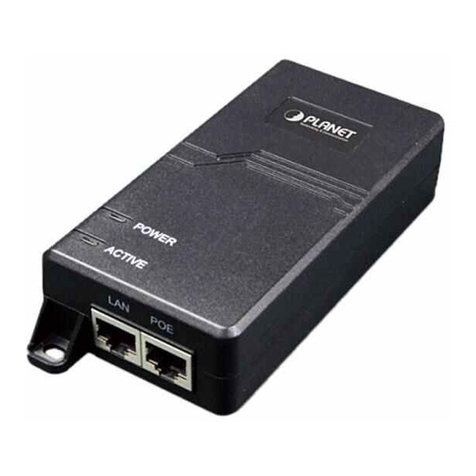
Planet Networking & Communication
Planet Networking & Communication POE-164 user manual
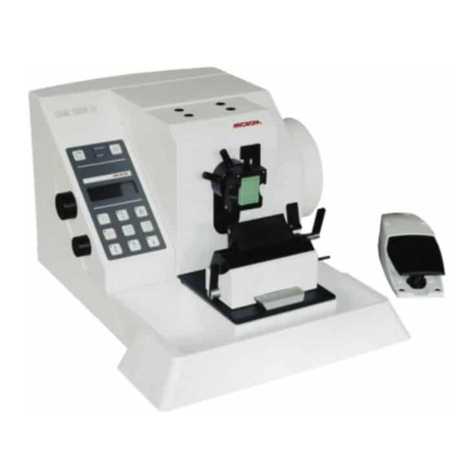
Microm
Microm HM 355 S instruction manual

Thermo Scientific
Thermo Scientific Fisherbrand GT2 instruction manual
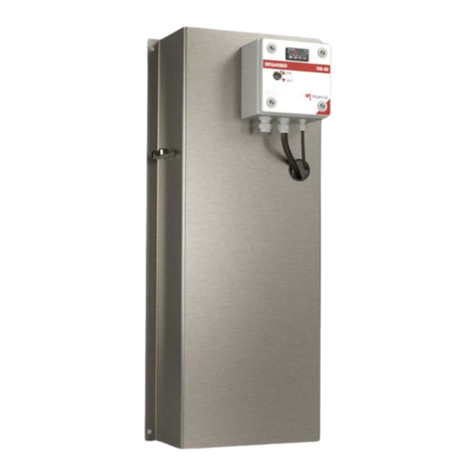
manvia
manvia DG-50 Installation, operation & maintenance manual

newster
newster NW30 user manual
